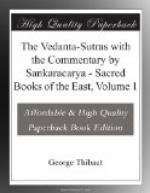To this argumentation we reply, that the quoted mantra by no means proves the Sa@nkhya doctrine to be based on Scripture. That mantra, taken by itself, is not able to give additional strength to any doctrine. For, by means of some supposition or other, the terms aja, &c. can be reconciled with any doctrine, and there is no reason for the special assertion that the Sa@nkhya doctrine only is meant. The case is analogous to that of the cup mentioned in the mantra, ’There is a cup having its mouth below and its bottom above’ (B/ri/. Up. II, 2, 3). Just as it is impossible to decide on the ground of this mantra taken by itself what special cup is meant—it being possible to ascribe, somehow or other, the quality of the mouth being turned downward to any cup—so here also there is no special quality stated, so that it is not possible to decide from the mantra itself whether the pradhana is meant by the term aja, or something else.—But in connexion with the mantra about the cup we have a supplementary passage from which we learn what kind of cup is meant, ’What is called the cup having its mouth below and its bottom above is this head.’—Whence, however, can we learn what special being is meant by the aja of the Sveta/s/vatara-upanishad?—To this question the next Sutra replies.
9. But the (elements) beginning with light (are meant by the term aja); for some read so in their text.
By the term aja we have to understand the causal matter of the four classes of beings, which matter has sprung from the highest Lord and begins with light, i.e. comprises fire, water, and earth.—The word ‘but’ (in the Sutra) gives emphasis to the assertion.—This aja is to be considered as comprising three elementary substances, not as consisting of three gu/n/as in the Sa@nkhya sense. We draw this conclusion from the fact that one sakha, after having related how fire, water, and earth sprang from the highest Lord, assigns to them red colour, and so on. ’The red colour of burning fire (agni) is the colour of the elementary fire (tejas), its white colour is the colour of water, its black




